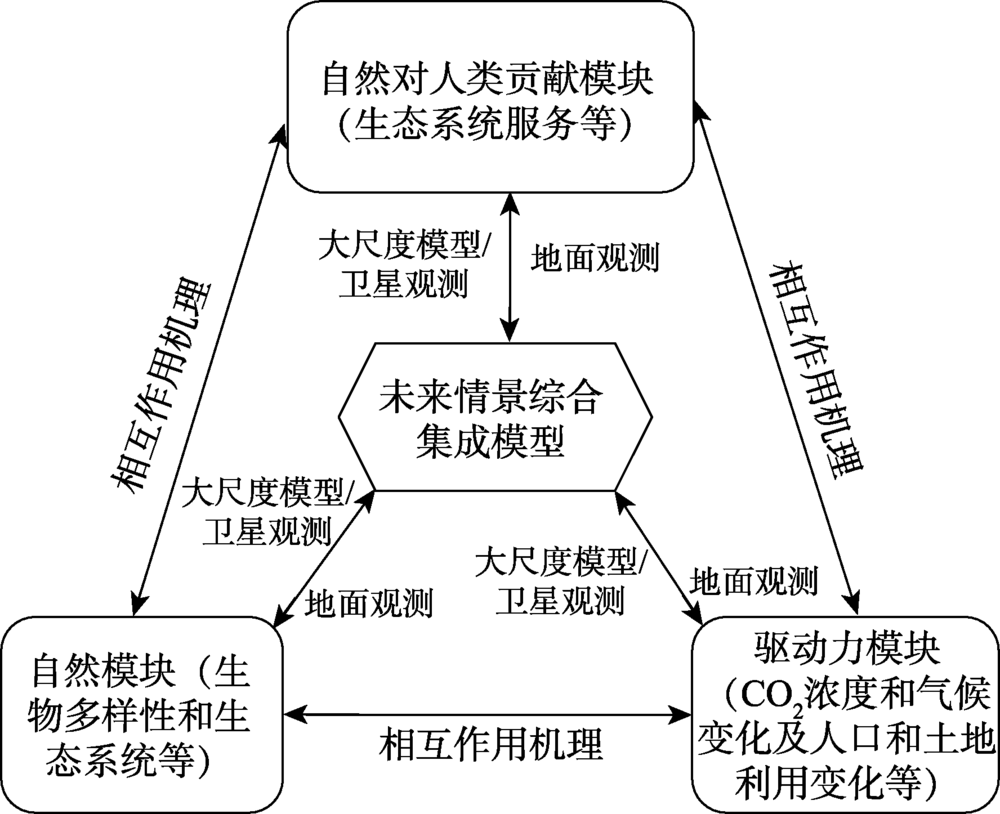

自然和自然贡献情景模型研究综述
|
岳天祥(1963— ),男,甘肃庆阳人,博士,研究员,主要研究方向为资源环境模型与系统模拟、生态环境信息学。 |
收稿日期: 2020-04-05
要求修回日期: 2020-04-20
网络出版日期: 2020-06-10
基金资助
国家自然科学基金项目(41930647)
国家自然科学基金项目(1590844)
国家自然科学基金项目(41421001)
国家自然科学基金项目(41971358)
中国科学院A类先导专项项目(XDA20030203)
资源与环境信息系统国家重点实验室自主创新项目(O88RA600YA)
生态环境部生物 多样性调查、观测和评估项目(2019 — 2023年)()
版权
Models and Scenarios for Nature and Nature's Contribution
Received date: 2020-04-05
Request revised date: 2020-04-20
Online published: 2020-06-10
Supported by
National Natural Science Foundation of China(41930647)
National Natural Science Foundation of China(1590844)
National Natural Science Foundation of China(41421001)
National Natural Science Foundation of China(41971358)
Strategic Priority Research Program(A) of the Chinese Academy of Sciences(XDA20030203)
Innovation Project of LREIS(O88RA600YA)
Biodiversity Investi- gation, Observation and Assessment Program (2019-2023) of the Ministry of Ecology and Environment of China()
Copyright
岳天祥 , 范泽孟 , 史文娇 , 赵娜 . 自然和自然贡献情景模型研究综述[J]. 地球信息科学学报, 2020 , 22(4) : 743 -750 . DOI: 10.12082/dqxxkx.2020.200163
In April 2012, a resolution was adopted for establishing "Intergovernmental science-policy Platform for Biodiversity and Ecosystem Services (IPBES)" as an independent intergovernmental body of United Nations (UN) according to the UN Office of Legal Affairs with the seat of the secretariat located in Bonn of Germany.IPBES has 136 members now and is continuously growing. China has formally joined IPBES after State Council of the People's Republic of China gave its stamp of approval in December of 2012. In order to guide the use of scenario analysis and modelling in all work under IPBES to ensure the policy relevance of its deliverables, 'the methodological assessment report on scenarios and models of biodiversity and ecosystem services' was firstly started up in early 2014, which was carried out by experts from all regions of the world. Its summary for policy-makers was approved by the fourth session of the Plenary of IPBES in February 2016 and has been launched in August 2016 in France. Nature, nature's contribution to people and driving forces of nature change are core concepts of the methodological assessment report. Nature includes biodiversity and ecosystems as well as earth system. Nature's contribution to people consists of ecosystem services and nature's gifts. Driving forces of nature change was classified into direct driving forces and indirect driving forces. Advanced work on scenarios and models of biodiversity and ecosystem services is one of deliverables of the work program up to 2030. We review background, history and contents of the scenarios and models of biodiversity and ecosystem services, describe the conceptual framework of IPBES scenarios include exploratory scenarios/attribution scenarios, policy-screening scenarios, target-seeking scenarios and retrospective policy evaluation, and discuss existing problems and perspectives for developing the models and scenarios. To find a solution for these existing problems on global level, a conceptual model is proposed for integrating dynamics of nature, changes of nature's contribution to people, and driving forces of the changes in terms of the fundamental theorem for Earth's surface system modeling. In the meanwhile, interactive mechanisms among nature, nature's contribution and driving forces are considered, along with combination of macro-pattern information and micro-process information.

| [1] |
陈述彭 . 序言[M]//岳天祥.资源环境数学模型手册. 北京: 科学出版社, 2003.
[
|
| [2] |
刘纪远, 岳天祥, 鞠洪波 , 等. 中国西部生态系统综合评估[M]. 北京: 气象出版社, 2006.
[
|
| [3] |
|
| [4] |
MA. Millennium ecosystem assessment-synthesis report[M]. Washington, DC: Island Press, 2005.
|
| [5] |
IPBES. The methodological assessment report on scenarios and models of biodiversity and ecosystem services[M]. Bonn, Germany: Secretariat of the Intergovernmental Science-Policy Platform on Biodiversity and Ecosystem Services, 2016.
|
| [6] |
|
| [7] |
|
| [8] |
|
| [9] |
IPCC. Climate change 2001: Synthesis report[M]. Cambridge: Cambridge University Press, 2001.
|
| [10] |
IPCC. Climate change 2007 - Synthesis report. Contribution of Working Groups I, II and III to the Fourth Assessment Report of the Intergovernmental Panel on Climate Change[M]. Cambridge: Cambridge University Press, 2007.
|
| [11] |
IPCC. Climate Change 2014: Synbook Report. Contribution of Working Groups I, II and III to the Fifth Assessment Report of the Intergovernmental Panel on Climate Change[M]. Geneva, Switzerland: IPCC, 2014.
|
| [12] |
UNEP. Global environment outlook 3[M]. London: EarthScan, 2002.
|
| [13] |
UNEP. Global environment outlook 4[M]. Nairobi: UNEP, 2007.
|
| [14] |
UNEP. Global environment outlook 5[M]. Geneva: UNEP, 2012.
|
| [15] |
CA. Water for food, water for life: A comprehensive assessment of water management in agriculture[M]. London: Earthscan, 2007.
|
| [16] |
|
| [17] |
|
| [18] |
|
| [19] |
|
| [20] |
|
| [21] |
|
| [22] |
|
| [23] |
|
| [24] |
|
| [25] |
|
| [26] |
|
| [27] |
|
| [28] |
|
| [29] |
岳天祥 . 资源环境数学模型手册[M]. 北京: 科学出版社, 2003.
[
|
| [30] |
|
| [31] |
|
| [32] |
|
| [33] |
|
| [34] |
|
| [35] |
|
| [36] |
|
| [37] |
|
| [38] |
|
| [39] |
|
| [40] |
|
| [41] |
|
| [42] |
|
| [43] |
|
| [44] |
|
| [45] |
傅伯杰, 于丹丹, 吕楠 . 中国生物多样性与生态系统服务评估指标体系[J]. 生态学报, 2017,37(2):341-348.
[
|
| [46] |
于丹丹, 吕楠, 傅伯杰 . 生物多样性与生态系统服务评估指标与方法[J]. 生态学报, 2017,37(2):49-357.
[
|
| [47] |
|
| [48] |
|
| [49] |
|
| [50] |
|
| [51] |
|
| [52] |
岳天祥 . 地球表层系统模拟分析原理与方法[M]. 北京: 科学出版社, 2017.
[
|
| [53] |
|
| [54] |
[
|
/
| 〈 |
|
〉 |